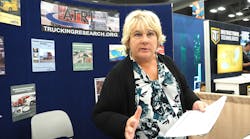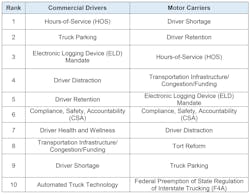AUSTIN, TX. In the American Transportation Research Institute's (ATRI) latest annual survey on the trucking industry's biggest issues, the driver shortage topped the overall list for the second straight year. But the survey's real insight could be in how drivers and motor carriers rank what's most important—for instance, for drivers, the driver shortage isn't even in the top five.
"For every motor carrier, if you really care about the driver shortage and driver retention, you'd better care what's on that driver list of issues," pointed out ATRI President Rebecca Brewster. Motor carriers ranked the driver shortage at number one and driver retention at number two, and if they're interested in addressing those two things, it's a good idea to see what drivers said is most important.
So look at it this way: every item that truck drivers rank on their top 10 issues list offers potential insight into those most painful issues—the driver shortage and retention—facing motor carriers.
Truck drivers ranked the federal Hours of Service (HOS) rules as number one. Now that the electronic logging device (ELD) mandate has been in full force nine months since April, there's been a shift among drivers perhaps not as frustrated with having to use the devices themselves as with the HOS rules that govern interstate truck drivers' time.
Behind the HOS rules, truck drivers told ATRI that truck parking is their number-two issue, followed by the ELD mandate, which, again, fell behind the HOS rules. Drivers' number-four issue is another key one to note: driver distraction.
From drivers' perspective, that's distraction among all those other motorists around them on the road. Truck drivers made this a top-five issue, while motor carriers have driver distraction as number seven on their list.
And from the carrier perspective, it could also be referring to distracted truck drivers, not distraction among other motorists. This is why the nuances in how these two respondent types, carrier and driver, rank the issues warrants attention.
In another significant point, truck drivers ranked automated truck technology on their list of top concerns. That didn't even make the list for carriers. While automated trucks may still be years away, drivers are reading the headlines and are starting to get concerned what self-driving trucks will do to their jobs and livelihood.
Here are the 2018 top 10 issues as ranked by commercial truck drivers and motor carriers:
Overall, however, here is ATRI's combined list for 2018:
1. Driver shortage. ATRI's Brewster noted that other issues have seen more repeats at the top of this annual list; one example is the economy, which was the number-one issue three years in a row around the Great Recession. But the driver shortage has been a heavyweight in a class all its own.
"The driver shortage has been a top-three issue in 12 out of the 14 years that we've done this survey," she said at the American Trucking Assns. (ATA) annual meeting in Austin, TX. "I started on this job in 1993, and in fact, one of the first studies I worked on 25 years ago was a driver shortage study."
Survey respondents' suggested fixes for the driver shortage largely focused on bringing 18-to-20-year-olds into the fray and allowing them to become interstate commercial truck drivers. But once again, it all depends on who you ask—in Fleet Owner's experience, truck drivers often say the job doesn't pay enough and to "pay us what we're worth."
2. Hours of Service (HOS). Flexibility, or lack thereof, in the federal HOS rules has been in the news frequently this year and is a top issue at the Federal Motor Carrier Safety Administration (FMCSA). It's no surprise this has popped up within ATRI's top three.
"The big issue with the Hours of Service rules is the lack of flexibility in the sleeper berth provision," Brewster said. "Respondents believe that exploring that and hopefully moving forward with flexibility in the Hours of Service rules is the preferred strategy."
Allowing a split in the 10-hour off-duty time truck drivers are required to take could also help truck drivers use some of that time to avoid heavy congestion they face on the road, she noted.
3. Driver retention. "This is closely related to the driver shortage—so it's not only how do we bring people into the industry, but how do we keep people in the industry," Brewster said.
A strategy that survey respondents suggested was to document and share what's working at motor carriers to keep drivers from leaving. "Everyone from the biggest fleets to the smallest fleets could take advantage of what works in their operations to keep our good drivers here," she noted.
4. The Electronic logging device (ELD) mandate. The dust is clearly settling a bit now for this issue as it dips down on this list. Last year, it was the overall number-two issue.
"Now that the mandate is in effect and the world didn't come to an end as some might've projected, I think there has been less concern or it has been eclipsed by concern over the Hours of Service rules," suggested Brewster.
5. Truck parking. Like the long and frequently cited driver shortage, truck parking has been on ATRI's top 10 list for many years. It's notable this year that drivers ranked it second on their list, while carriers ranked it ninth.
"Parking impacts the driver every single day," Brewster noted. "There are things that are being done about truck parking, but we're still a long way to resolving that situation."
6. Compliance, Safety, Accountability (CSA). This program at FMCSA kept its number-six spot from last year on ATRI's list, one of only a few items to have done that. It's being addressed now as FMCSA works to implement a better program, but a top concern housed within this issue is crash reporting for motor carriers.
That alone has been difficult to standardize across the board and make equitable for carriers—FMCSA has struggled with how best to address crash reporting for many years.
7. Driver distraction. As noted above, this was more of a burning issue for truck drivers than it was for carriers. The National Highway Traffic Safety Administration recently pointed out that not only is distracted driving widely understood to be a top and growing issue, it's likely significantly underreported—so it could be even bigger than anyone thinks.
Truck drivers wouldn't be surprised at that. Time and time again, Fleet Owner has heard how truck drivers are in a perfect position to see who's driving distracted, since they sit at a higher vantage point and can easily see into passenger cars around them.
Brewster pointed to something else, though, as distraction relates to truck drivers: maybe it's a byproduct of so much technology getting crammed into trucks today.
"Interestingly, one of the strategies for driver distraction is to look at what's going on inside the cab," she noted. "Are we deploying so many different safety technologies and other things inside the cab that perhaps we're creating some unintended distraction?"
8. Transportation infrastructure/ traffic congestion/ funding. With the amount of times this issue came up at ATA's conference—and the fervor with which it came up—you'd think the nation's roads and bridges would've ranked higher on ATRI's top 10 list. Brewster even said as much.
ATRI just released its latest assessment and determined the cost of congestion is 1.2 billion hours of lost productivity. That works out to a cost of $74.5 billion to trucking companies and is the equivalent of 425,000 truck drivers sitting still for an entire year.
"We talk about the driver shortage being the number-one issue, and congestion alone zaps us of 425,000 drivers' worth of productivity," Brewster pointed out. "If we're all so concerned about it, why is it not higher on the list?"
"The driver shortage I'm feeling very painfully because I can't move freight," she added, speaking from a carrier's perspective. "Hours of Service rules are very much in the news right now. But infrastructure is a consistent issue; it's been on the list a long time. Maybe people have just become used to it."
Still, in an industry where drivers are largely paid by the mile, everyone may be focused on inflexibility in the HOS rules, but infrastructure problems and congestion are a huge driver for much of the angst surrounding HOS.
9. Driver health and wellness. This is another area where carriers need to read between the lines. Other issues like the driver shortage and driver retention may be how carriers see problems, but it's the underlying and secondary issues from the driver's perspective that are likely contributing to the driver shortage and turnover/ churn.
"We've got to really, really focus on how we can best take care of the men and women who drive professionally," Brewster emphasized. "Take driver retention and driver shortage—if this is a career where I feel I'm not going to be taken care of and have opportunities to improve my own health, it's not a career I'm going to want to stay in."
10 .The economy. It may seem odd for the economy to creep into the top 10 issues for trucking right now given the booming year trucking has been seeing. But indeed there are some concerns, such as what was going to happen with NAFTA prior to that issue being resolved recently as well as with tariffs that could harm trade or drive up the cost of materials.
"This has generated significant concern among industry stakeholders, many of whom depend on strong import and export activity to drive freight demand," ATRI stated in its survey report.




